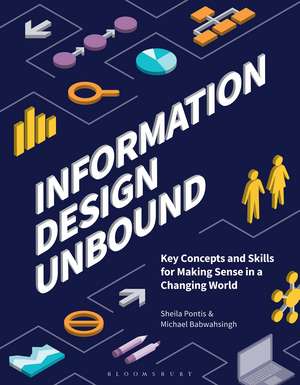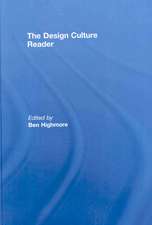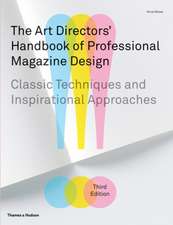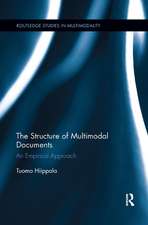Information Design Unbound: Key Concepts and Skills for Making Sense in a Changing World
Autor Dr Sheila Pontis, Michael Babwahsinghen Limba Engleză Paperback – noi 2023
Preț: 208.89 lei
Preț vechi: 236.96 lei
-12% Nou
Puncte Express: 313
Preț estimativ în valută:
39.98€ • 43.45$ • 33.61£
39.98€ • 43.45$ • 33.61£
Carte disponibilă
Livrare economică 31 martie-14 aprilie
Livrare express 15-21 martie pentru 77.90 lei
Preluare comenzi: 021 569.72.76
Specificații
ISBN-13: 9781350054134
ISBN-10: 1350054135
Pagini: 272
Ilustrații: 400 colour illus
Dimensiuni: 210 x 270 x 16 mm
Greutate: 0.91 kg
Editura: Bloomsbury Publishing
Colecția Bloomsbury Visual Arts
Locul publicării:London, United Kingdom
ISBN-10: 1350054135
Pagini: 272
Ilustrații: 400 colour illus
Dimensiuni: 210 x 270 x 16 mm
Greutate: 0.91 kg
Editura: Bloomsbury Publishing
Colecția Bloomsbury Visual Arts
Locul publicării:London, United Kingdom
Caracteristici
Addresses an unmet need for a comprehensive information design textbook bridging theory, practice, and contemporary challenges including case studies and exercises
Notă biografică
Sheila Pontis is lecturer at Princeton University (USA), honorary research associate at UCL (UK), and partner at Sense Information Design. Since 2002, she teaches and facilitates workshops on information design, design research, ethnography, and design thinking in Argentina, Spain, the UK and the US. She has produced work for diverse organisations in the US, South America and Europe including Pfizer, TfL, Elsevier, Unilever and NHS. Michael Babwahsingh is an information designer and partner at Sense Information Design. His experience spans strategic design and innovation, branding, and communication design for corporate and non-profit clients. He has taught design thinking at NYU Wagner Graduate School of Public Service. Michael received a BA in Art and Graphic Design from Moravian College.
Cuprins
IntroductionPART I. Context1. Understanding information design1.1 Finding our way every day1.2 Building a working definition1.3 Mapping out the landscape1.4 Seeing the bigger picture1.5 What is effective information design?1.6 Tracing the historical roots1.7 Information design comes of ageExercises2. How information designers work2.1 What makes an information designer?2.2 A collaborative, cross-disciplinary practice2.3 Ethics and professional conduct2.4 Working with the information design process2.5 The scale of information design challengesExercises3. How we process visual information3.1 The visual information processing system3.2 Vision3.3 Perception3.4 Learning and retrieval3.5 Thinking and problem-solvingExercises4. How we create meaning4.1 Understanding culture4.2 Signs, the basic units of meaning4.3 Rhetoric and communication4.4 Society, identity, and representationExercisesPART II. Skills5. Thinking and working visually5.1 Giving shape to thought5.2 Assembling your visual toolkit5.3 Learning to sketch5.4 Using diagrams to think5.5 Making use of space and formExercises6. Learning through research6.1 A structured search for knowledge6.2 Understanding the subject matter6.3 Understanding the audience6.4 Planning out your research6.5 Collecting dataExercises7. Sensemaking for communication7.1 Planning before designing7.2 Constructing knowledge7.3 Organizing informationExercises8. Designing with clarity8.1 Focusing on effectiveness8.2 Content8.3 Structure8.4 Presentation8.5 Engagement8.6 PerformanceExercisesPART III. Practice9. Communications9.1 Working with communications9.2 Project Re:form9.3 GAIA Amazonas icon system9.4 Emergency ventilator instructions9.5 We Are Here: An Atlas of Aotearoa10. Experiences10.1 Working with experiences10.2 Nemus Futurum interactive visitor experience10.3 SEPTA wayfinding master plan10.4 Skicircus wayfinding system10.5 Seat at the Table interactive exhibit11. Organizations11.1 Working with organizations11.2 Oregon Museum of Science and Industry vision and strategy11.3 Integrated journey maps12. Systems12.1 Working with systems12.2 Understanding elderly isolation in Pittsburgh12.3 Systems approach to youth employment in Bhutan12.4 Navigating the complexity of cancer diagnosisResourcesBibliographyIndexAcknowledgmentsImage credits





